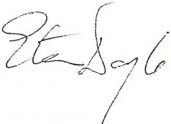S.I. No. 505/2003 - Wireless Telegraphy Act, 1926 (Section 3) (Exemption of Certain Classes of Fixed Satellite Earth Stations) Order, 2003
The Commission for Communications Regulation, in exercise of the powers conferred on it by section 6 (1) of the Wireless Telegraphy Act, 1926 (No. 45 of 1926), transferred to the Commission for Communications Regulation by section 9 (1) of the Communications Regulation Act 2002 (No. 20 of 2002) hereby makes the following Order: 1. This Order may be cited as the Wireless Telegraphy Act, 1926 (section 3 (Exemption of Certain Classes of Fixed Satellite Earth Stations) Order, 2003. 2. The Interpretation Acts, 1937 to 1997, apply to this Order. 3. In this Order - | ||||||||||||||||||||
“CEPT” means the European Conference of Postal and Telecommunications Administrations; | ||||||||||||||||||||
“EIRP” (Equivalent Isotropically Radiated Power) means the product of the power supplied to the antenna and the antenna gain in a given direction relative to an isotropic antenna; | ||||||||||||||||||||
“EN 301-459” means a harmonised standard which is a Harmonised European Norm for Satellite Interactive Terminals (SIT) and Satellite User Terminals (SUT) transmitting towards Satellites in geostationary orbit in the 29.5 to 30.0GHz frequency bands covering essential requirements under Article 3.2 of the R&TTE Directive; | ||||||||||||||||||||
“ERC” means the European Radiocommunications Committee of CEPT; | ||||||||||||||||||||
“ERC/DEC/(00) 03” means ERC Decision of 27 March 2000 on exemption from individual licensing of Satellite Interactive Terminals (SIT) operating within the frequency bands 10.70-12.75GHz Space to Earth and 29.50-30.00GHz Earth to Space; | ||||||||||||||||||||
“ERC/DEC/(00) 04” means ERC Decision of 27 March 2000 on exemption from individual licensing of Satellite User Terminals (SUT) operating within the frequency bands 19.70-20.20GHz Space to Earth and 29.50-30.00GHz Earth to Space; | ||||||||||||||||||||
“ERC/DEC/(00) 05” means ERC Decision of 28 March 2000 on exemption from individual licensing of Very Small Aperture Terminals (VSAT) operating within the frequency bands 12.5-12.75GHz Space to Earth and 14.00-14.25GHz Earth to Space; | ||||||||||||||||||||
“ETSI” means the European Telecommunications Standards Institute; | ||||||||||||||||||||
“Harmful Interference” means interference with the working of or interference which otherwise injuriously affects any apparatus for wireless telegraphy in respect of which a licence has been granted under the 1926 Act and is in force or any apparatus for wireless telegraphy lawfully maintained or worked without any such licence or any broadcasting station maintained under Part II of the 1926 Act or under the Broadcasting Authority Act 1960 ; | ||||||||||||||||||||
“Harmonised Standard” means a technical specification adopted by a recognised standards body under a mandate from the European Commission in uniformity with the procedures laid down in Directive 98/34/EC as amended from time to time, for the purpose of establishing a European requirement, compliance with which is not compulsory; | ||||||||||||||||||||
“Satellite Earth Station” means apparatus for wireless telegraphy, located on the Earth's surface, intended for the transmission of radio signals to, and/or the reception of radio signals from a space station; | ||||||||||||||||||||
“SIT Station” means an earth station adapted or designed to operate as covered by ERC/DEC/(00) 03 and EN 301-459; | ||||||||||||||||||||
“Space Station” means apparatus for wireless telegraphy that is located on an object which is beyond the major portion of the Earth's atmosphere and which is not a high altitude platform station; | ||||||||||||||||||||
“SUT Stations” means an earth station adapted or designed to operate as covered by ERC/DEC/(00) 04 and EN 301-459; | ||||||||||||||||||||
“TBR 28” means Technical Basis for Regulation 28 of December 1997 produced by the Satellite and Systems (SES) Technical Committee of ETSI; | ||||||||||||||||||||
“The Regulations” means the European Communities (Radio Equipment and Telecommunications Terminal Equipment) Regulations, 2001 ( S.I. No. 240 of 2001 ); | ||||||||||||||||||||
“VSAT Stations” means an earth station adapted or designed to operate as covered by ERC/DEC/(00) 05; 4. The following classes of apparatus for wireless telegraphy are hereby declared to be classes of apparatus for wireless telegraphy to which section 3 of the Wireless Telegraphy Act 1926 does not apply, namely, the classes of apparatus for wireless telegraphy described in Schedule 1 to this Order. 5. Where a user or operator requests protection from harmful interference and or co-ordination for a VSAT, SIT or SUT, then this Order shall not apply and the user or operator shall apply for a licence under the Wireless Telegraphy (Fixed Satellite Earth Stations) Regulations 2000, S.I. No. 261 of 2000 . | ||||||||||||||||||||
|
SCHEDULE 1 | ||||||||||||||||||||
Apparatus for wireless telegraphy to which Section 3 of the Wireless Telegraphy Act 1926 does not apply | ||||||||||||||||||||
(1) VSAT, SIT and SUT Stations which: | ||||||||||||||||||||
(a) are described in column 1 of table 1, | ||||||||||||||||||||
(b) fulfil the requirements laid down in the harmonised standards set out in column 2 or otherwise meet the essential requirements of the Regulations, | ||||||||||||||||||||
(c) operate in the frequencies in column 3 in table 1, | ||||||||||||||||||||
(d) have an EIRP of 50dBW or less, | ||||||||||||||||||||
(e) are located more than 500 metres from the boundary fence of an airport and | ||||||||||||||||||||
(f) in any event fulfil all requirements of the Regulations. | ||||||||||||||||||||
| ||||||||||||||||||||
| ||||||||||||||||||||
|
EXPLANATORY NOTE | ||||||||||||||||||||
(This note is not part of the Instrument and does not purport to be a legal interpretation.) | ||||||||||||||||||||
This Order provides for the exemption of certain wireless telegraphy stations and apparatus from the requirement to be licensed under the Wireless Telegraphy Act, 1926 . | ||||||||||||||||||||

